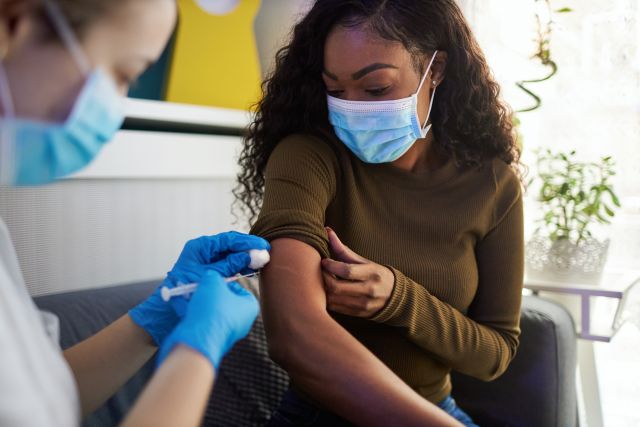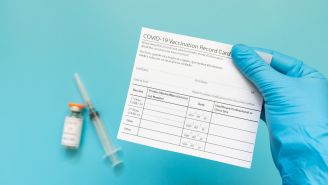Updated on January 24, 2022.
As we enter year three of the pandemic, you may have heard a few things about how the COVID-19 landscape is changing. Perhaps you’ve heard the tidal wave of infections caused by Omicron is finally starting to subside, allowing us to let down our guard and go back to normal. To be sure, there is a lot of reason for optimism, but there is still work to be done if we want this pandemic to end.
You may have also heard that previous infection is just as protective—or more protective—than vaccination. Unfortunately, it’s not that simple.
You may also be hearing frustrated voices casting doubt on the need for masks, suggesting they’re not effective against Omicron. That’s just not true.
At a time when confusion is swirling, focus on the facts. What do we know is 100 percent true? COVID precautions are still saving lives, keeping people out of overwhelmed hospitals, and helping to slow the spread of COVID-19. The more people who continue to follow these guidelines, the better off we all are.
As Obiora Okafor, an independent expert on human rights and international solidarity put it, the pandemic won’t end for anyone, until it ends for everyone.
The latest on Omicron
The good news first: Better times may be coming, as some evidence suggests Omicron infections have peaked. After skyrocketing to about 800,000 each day, reported cases are beginning to fall in some parts of the U.S., including large metropolitan areas like New York City, Boston, and Cleveland. This follows trends in places like South Africa and England, where Omicron struck quickly and rapidly receded.
Prevention and treatment have improved, as well. The Centers for Disease Control and Prevention (CDC) reports that about two-thirds of Americans aged 5 years and older are fully vaccinated, and tens of millions of people have received booster shots. Compared to a year or two ago, healthcare providers have many more tools to manage COVID-19, as well—to help keep at-risk people out of the hospital and treat those who do become ill.
We’re far from where we were in 2020, but if we’ve learned anything, it’s that we can’t predict the future with certainty.
Omicron is still spreading in many areas of the country and overall hospitalizations and deaths remain high. In mid-January, nationwide COVID hospitalizations exceeded 160,000—well past their Delta-wave peak—and between 1,500 and 1,800 infected people died each day. Additional mutations could continue to slow recovery and play a role in keeping infections going—at least in the short-term.
Remember, the steps you’re being asked to take—from masking to testing and vaccinating—are intended to control the coronavirus—not you. Being patient and smart about what we do now, will play a role in what happens next.
Natural or hybrid immunity is risky
On January 19, 2022, the CDC released data showing that people who were previously infected with COVID-19 had more protection against the Delta variant than those who were vaccinated and had not been infected. Many people took this to mean that natural immunity is better than vaccine-induced immunity. This thinking is misguided.
Why? Millions of people were vaccinated several months before the Delta surge. Researchers monitoring the vaccines warned their effectiveness was waning over time, prompting U.S. health officials to authorize the use of COVID boosters to bolster protection against the disease, starting with those most vulnerable to serious infections and complications.
The study’s data collection stopped in November 2021. At the time, only a few months had passed since the booster become available, and only certain high-risk groups were eligible.
Since then, the CDC released newer data on January 21 showing that around the time the Delta wave ended and the Omicron wave began protection against infection was more than five times higher among boosted people than those who were unvaccinated, particularly adults ages 50 years and older.
Delta is a more severe COVID strain, and we know that severe infections produce a more robust immune response than mild ones. But this doesn’t make the case for exposing yourself or anyone to the virus—or even hybrid immunity (vaccination plus natural immunity from a previous COVID infection).
Scientists are just scratching the surfacing when it comes to understanding the long-term risks of COVID infection, which may include breathing problems, heart complications, an increased risk for diabetes, stroke and more. The disease, which can damage the lungs, brain, and heart, has killed more than 860,000 Americans as of January 21, and millions more have gotten sick.
By contrast, the shots are safe and effective. Most side effects resolve in a few days and serious complications are rare. Since they became widely available, the vast majority of deaths have been among the unvaccinated.
Meanwhile, the protection that hybrid immunity offers may vary from one person to the next and it can decline over time. It’s not a guarantee or a one-way ticket out of the pandemic.
Even though Omicron has resulted in more breakthrough cases, vaccination remains—hands down—the best way to protect yourself and others from COVID-19 infection, serious illness, hospitalization, and death. If you are not yet vaccinated or are fully vaccinated but not boosted, now is the time to get your shots.
The story on masks
As the pandemic rolls on, masks are once again ruffling feathers. The reasoning often goes: Since Omicron spreads so easily, masks don’t work. Mandates have been dropped in many places across the U.S., and some states have even banned mandatory masking requirements in schools against the recommendations of public health officials.
The truth is that masks help protect against Omicron, Delta and other COVID variants. Numerous studies suggest that transmission rates are lower in places with good mask usage. In a pair of October 2021 studies, for example, CDC experts found that outbreaks were much more likely to occur in schools without mask mandates than in those with mandates.
That said, while any mask is better than no mask, some offer significantly more protection than others. Least effective are loosely woven cloth masks. Most effective are N95s and KN95s. In fact, on January 19, several news outlets reported the Biden administration plans to ship 400 million N95 masks to distribution sites across the U.S. in the coming weeks.
Whatever you choose, a critical feature of any mask is that it fits snugly and comfortably against your face. If you use a cloth mask, make sure it has multiple layers of fabric or wear a disposable mask underneath.
The basic recommendations for mask usage haven’t changed. In general, unvaccinated people age 2 years or older should continue wearing a mask in public indoor locales and on public transportation. If you are fully vaccinated, you may choose to wear a mask:
- Whenever you want
- If you or someone in your home is immunocompromised or at higher risk for severe disease
- If someone in your home is unvaccinated, not up to date on their vaccines, or ineligible for shots
- In areas where COVID case rates are high or on the rise
You usually don’t need a mask outdoors, except in crowded spaces in areas with high or on-the-rise case counts.
It may be annoying or bothersome but it’s a small—and temporary—price to pay. Studies show there really are no risks or health-related downsides to wearing a mask as directed, unless it’s during an intense workout.
More common-sense ways to continue protecting yourself
Other ways you can safeguard yourself, your family, neighbors, friends, co-workers and healthcare providers from the coronavirus:
- Be aware that spending time in crowded indoor areas with poor ventilation places you at higher risk for COVID. Open windows and doors for circulation whenever possible.
- Wash your hands frequently or use a sanitizer containing at least 60 percent alcohol. This can also help prevent transmission of other viruses, such as the flu.
- Cover your mouth when you sneeze or cough.
- If you are unvaccinated, keep a 6-foot distance from others in public indoor areas.
- Watch out for symptoms such as fever, headache, sore throat, runny nose, and cough. While some people with Omicron are not reporting the loss of smell and taste common to other COVID variants, keep an eye out for them, as well. Seek help immediately for severe issues like chest pain or trouble breathing.
If you have symptoms, get tested. If you have come into close contact with an infected person, get tested at least five days after your last contact. If you’re gathering with others indoors, consider taking an at-home test first, whatever your vaccination status and whether or not you have symptoms.






